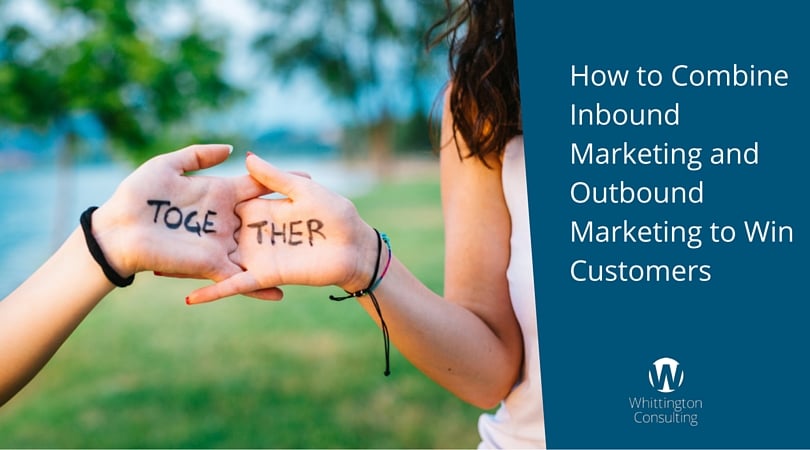Even though our firm only works with online marketing, I'd be unrealistic to think that your business will ditch paid advertising and "traditional media."
Paid advertising and traditional media will have a place in your company's marketing budget for the foreseeable future, but an inbound marketing strategy is something your business needs to develop now in order to stay competitive.
An integrated marketing plan can combine certain aspects of inbound marketing with outbound marketing ideas in order to pull in more customers. First, let's look at the difference in case you're just hearing about inbound marketing for the first time, and then we'll look at how you can combine the two to amplify your results.
The Difference Between Inbound and Outbound Marketing
For a long time, there was the status quo. Companies embraced PR, they paid for magazine, radio, TV ads, they went to trade shows. They paid to play. Then the internet became mainstream and it opened up new ways to promote your business. Now years later, marketing gurus have described it this way:
- Inbound marketing - Getting the potential client to come to you. Marketing with a magnet instead of beating prospects over the head with a message that interrupts.
- Outbound marketing - Interrupting the potential client with your message and letting them know about your business. You pay for the placement, and a small percentage take a desired action.
Traditional techniques would fall under outbound marketing, which would include things like radio/TV ads, print ads, billboards, mailers, etc. You would actually be going outside of an arena you control in order to pull in customers. The problem with this is that you are paying a set amount of money for a certain amount of time for these third parties to promote your business. As soon as the money stops coming in from you, they stop promoting you.

Inbound marketing techniques deal with bringing people to something you have control over -- your company's website. This is done by putting content on the site that people want to see, something that gives them useful information when they search for it.
Bringing Together Inbound and Outbound Marketing
Both inbound marketing and outbound marketing have their merits. But can you make your paid advertising more effective by combining it with inbound techniques?
Combining the two may seem difficult to understand at first, but it actually makes a lot of sense. Imagine you are a physician specializing in back pain and put a lot of information on your website about dealing with back pain. Because you may have several competing practices in your area, you might take out an ad in a local magazine.
You've probably placed ads like this -- a physician photo, a practice name and a phone number. The problem with this ad is that people don't just see ads an pick up the phone anymore. Information is freely available on the internet, and so they do some research when they are not at work and when your office is closed. They aren't looking for a diagnosis, just information. And what we know about these people is that they trust practices that put helpful information online.
Instead, let's say you placed that magazine ad directing them to your website to read an article called "How to Prevent Back Pain While Sitting At Your Desk." The article might talk about when it's time to see a doctor and include a link to an appointment request form.
Instead of just advertising your practice, you've helped them solve a problem.
Why Inbound Marketing is a Good Fit for Your Business
At least 81% of people look online before they make a major purchase. A lot of what they are searching for has to do with information on a particular product or service. Even in the manufacturing industry, the internet plays an important role in determining where a client decides to take their business. If someone looking for information finds it on your website, they are going to be more likely to get in touch.
What Are Some Practical Ways to Combine Inbound and Outbound Marketing?
A few practical examples of how inbound and outbound marketing can work together include:
- Using email marketing lists that you've built organically and your company social media profiles to send out trade show booth invitations and RSVPs ahead of an upcoming trade show.
- Having sales reps call people that simply download brochures, whitepapers and guides from your website.
- Monitoring social media profiles of companies you meet at trade shows to collect intelligence and provide clues for when you should follow up by phone, like around an acquisition or round of funding.
- Sending out email "thank yous" by email to trade show booth attendees and offer them your latest whitepaper or guide.
- Referencing a lead generation offer on your website like a whitepaper during a speaking engagement.
- Linking to a lead generation offer for download on your website from a trade publication advertisement rather than just showing information about your company in the ad.
- Using website analytics to make a list of companies that visited your website, then compiling a prospect call list.
Increasing your inbound marketing reach also has the effect of stretching your advertising dollar. Outbound marketing methods might be effective as long as you're paying top dollar for them. Combine your paid advertising with inbound marketing and you'll create marketing that people can actually use.
Would you like help combining inbound and outbound marketing to get a steady stream of leads? We're happy to have a first conversation to see how this might work for your business. Here's where you can request an inbound marketing assessment if you're so inclined.








